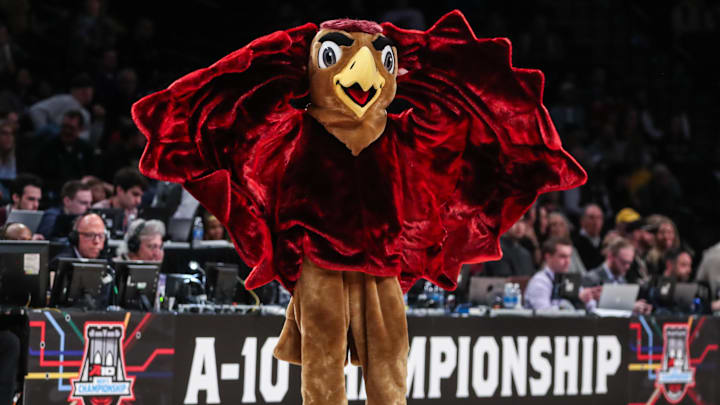A10 Conference Surprising Beneficiary of Western Schools Realignment

College basketball blue-bloods have captivated the nation, showcasing NBA-bound one-and-done talent, sell-out arenas, and prolific coaches. However, mid-major basketball holds an essential place in the heart of any proper college basketball fan. Mid-major hoops reap significant revenue generation and television viewership by scratching the itch of those who enjoy watching young teams develop into seasoned units, unique traditions, and devoted fan bases –– and in my very biased opinion, the Atlantic 10 Conference does it better than anyone.
Let’s get the mandatory disclosures out of the way. I love the A10; I love everything about it. I was a student-athlete at St. Joe’s and am currently employed by Loyola Chicago. I am often overly romantic about the beauty of the league. I can also admit that in recent memory, the gold standard of mid-major basketball is not a title that can be claimed by the A10.
The American Athletic Conference, Mountain West Conference, and West Coast Conference have all provided better products to mid-major fans, but as football-centric conference realignment continues to flip the structure of conferences west of the Mississippi River on its head, a shift of power back to the A10 is certain.
This season will mark the end of an era of dominance by western mid-majors. In 2024, the Mountain West outpaced many high-major conferences, sending six teams to the tournament, which tied the Big 10 and was bested by only the SEC and Big 12. According to conference-wide RPI, this wasn’t a fluke; top to bottom, the Mountain West was the fourth-best conference in the country –– outperforming the ACC, Big East, and the PAC 12.
Sadly, the Mountain West is unable to continue its ascension to the highest level of college basketball. In the wake of the near dissolution of the PAC 12, the Mountain West has been pillaged by the regionally similar power conference. Two-thirds of the MWC teams that received bids in the 2024 NCAA Tournament have been poached by the PAC-12: San Diego State, Boise State, Utah State, and Colorado State. Those teams will formally be introduced as PAC 12 members after this season.
To fill the void of these programs, the Mountain West has committed to adding two middling basketball programs in Hawaii and the University of Texas El Paso. The conference remains a shell of its former self, with New Mexico, Nevada, and UNLV providing the only teams that maintain national relevance. The Mountain West will still be able to place multiple teams in the NCAA tournament, but the matchups and depth that made the conference rival the strength of the Big East are in the rearview mirror.
The WCC suffered the most significant loss of the upcoming realignment when the PAC 12 poached basketball juggernaut Gonzaga. In 2023, the WCC lost its second most prominent brand, BYU, to the Big 12. While the bottom of the WCC has routinely been awful, Gonzaga, BYU, Saint Mary’s, and San Francisco have consistently put together tournament-worthy teams, and the WCC has been a perennial two-bid league.
Without BYU or Gonzaga, the WCC has lost its most prominent brands and best programs. The top two conference championships by viewership in the WCC have each come when BYU faced off against Gonzaga; now, both programs have sought greener pastures. Remarkably, Gonzaga has appeared in the WCC championship every year since 1997, making it nearly impossible to find reliable data on dips in viewership during their absence.
The media draw to the WCC was the anticipation of watching David slay Goliath. A good BYU, San Francisco, or St. Mary’s team always had the chance to defeat a Gonzaga program that rarely fell out of the top 10 in the AP poll. Without Gonzaga, conference games don’t have the same appeal. There’s little draw or March Madness bid consequence for most matchups now. The WCC, like the Mountain West, is facing a future as a one- or maybe two-bid league.
The other big player within the mid-major scene, the American Athletic Conference, has not been impacted by the upcoming realignment from the PAC 12 but has lost many top member schools to power conferences. Big market programs Houston and Cincinnati recently left for the Big 12 conference after showing sustained success—both have had six tournament appearances in the last decade. SMU and UCF also departed the AAC, and while not as prolific on the hardcourt, losing both schools’ respective media markets of Dallas and Orlando has harmed the conference’s visibility.
The Mountain West, WCC, and AAC have lost their basketball anchors, while the Atlantic 10 has remained stable and incredibly competitive. The Atlantic 10 has avoided heavy realignment over the last decade, only swapping UMass Amherst for Loyola Chicago. In a landscape where other mid-majors are scrambling to recover from realignment, the A10 is well-positioned to emerge as the premier mid-major conference and starts with its depth.
At every tier of competitive programs that could challenege for a tournament berth, the A10 holds the greatest volume of teams, making it the deepest mid-major league in the country.
Teams in the Top 50:
A10: Dayton (27), VCU (41)
AAC: Memphis (43)
MWC: None
WCC: St. Mary’s (34)
Teams Ranked 51-100:
A10: Loyola Chicago (79), St. Joe’s (86), George Mason (98)
AAC: North Texas (81), FAU (83)
MWC: New Mexico (62), Nevada (73), UNLV (94)
WCC: San Francisco (85), Santa Clara (95)
Teams Ranked 101-150:
A10: St. Louis (105), Rhode Island, St. Bonaventure (123), Davidson (125), Richmond (139), Duquesne (143), George Washington (146)
AAC: Wichita State (101), South Florida (102), FAU (104), East Carolina (126), Charlotte (128), Temple (138),
MWC: None
WCC: LMU (131)
This A10's depth ensures that matchups through conference play will have postseason implications. With many teams on the tournament bubble, the stakes are high, and each game could shift the entire NCAA tournament landscape. It's not just A10 fans paying attention — fans of bubble teams across the country are watching closely, as A10 games have consequences for who gets into March Madness.
The A10's ascension couldn’t be happening at a better time for the conference’s media exposure. In 2023, the Atlantic 10 secured a five-year extension of its broadcast agreements with CBS Sports, NBC Sports, and ESPN that begins this season. Even before conference realignment, the A10’s media partners valued their games; the new deal provides a 40% increase in revenue and dramatically expands where A10 sports will be marketed and televised.
Ninety-eight games across men’s and women’s basketball will be nationally broadcast, with twenty-eight receiving in-studio coverage. With other mid-majors weakened by realignment, the timing of this expanded coverage only helps the A10 to capitalize on its newfound role as the must-watch mid-major conference. The A10’s position as a bubble battleground makes it a compelling draw for broadcasters looking to capture high-stakes matchups. In 2029, when the A10's media rights contract expires, an even bigger deal could help cement the conference’s position.
Another factor favoring the A10’s rise to prominence is the absence of football, which allows its member schools to concentrate NIL funding and resources exclusively on basketball. The AAC, which shares a similarly deep portfolio of teams, must split resources between football and basketball. No matter what the future structuring of college athletics morphs into, NIL resources will remain paramount in attracting and retaining talent.
Football rosters are much bigger than basketball rosters. The NIL payroll it takes to fund a competitive football team dwarfs that of fielding a competitive basketball team. Basketball-only schools in the A10, Big East, and the WCC have a distinct advantage over any conference that is offering football. This could be the differentiator for the A10 while they jockey for power against the AAC.
The Atlantic 10 is ready to seize this moment. The Mountain West and WCC will attempt to rebuild, but the A10 has emerged as the most stable, deep, and compelling mid-major conference in college basketball. With expanded media coverage, a basketball-focused approach to NIL, and a conference full of teams ready to make postseason noise, the A10 continues to smile as chaos unfolds on the West Coast.
